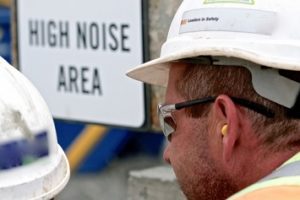It’s important to identify and address potentially hazardous workplace noise. In addition to hearing loss, noise can increase stress levels, create safety issues, and contribute to a number of health problems. But how can you sort hazardous noise from harmless noise—or even from helpful and useful sounds?
Here’s some guidance from the Occupational Safety and Health Administration’s (OSHA) occupational noise standard (29 CFR 1910.95) and from the National Institute for Occupational Safety and Health (NIOSH).
Sleuthing for Sound
In order to figure out whether the noise in your workplace could be violating OSHA’s rules or causing problems for your workers, you’ll need to become a sound sleuth of sorts. It can be helpful to begin with a map of your workplace and use it to identify areas where there is:
- Continuous noise, like a constant background thrum of machinery and equipment
- Intermittent noise, like machines or equipment that only run intermittently, or sounds that are pulsing, pounding, or variable in volume
You may also want to look at a schedule and consider whether noise levels vary by:
- Time of day. Is the workplace noisier on first and second shifts than on third shift?
- Type of tasks being performed. Is the workplace noisier when workers are fabricating than when they are finishing a work piece?
You can then quantify noise levels to determine whether they may exceed OSHA’s exposure limits. You should begin by quantifying sound levels in different areas of your workplace, at different times of day, using appropriate monitoring tools.
OSHA vs. NIOSH: How Loud Is Too Loud?
When you quantify noise levels, you’ll want to answer the question: is it too loud? OSHA and NIOSH answer that question differently.
Sound is measured in units called decibels (dB). In workplaces, sound levels are measured on a weighted scale, called the A-weighted scale, that registers frequencies of sound within the range of human hearing as “louder” than those that fall outside that range (abbreviated dBA). OSHA’s permissible exposure level (PEL) for occupational noise is 90 dBA as an 8-hour time-weighted average (TWA). Because noise is measured logarithmically rather than on a linear scale, an increase of 3–5 dB represents an approximate doubling of sound intensity. Therefore, OSHA’s action level for occupational noise—half the PEL or a 50% dose—is 85 dBA as an 8-hour TWA.
NIOSH recommends that employers consider limiting worker exposures to 85 dBA rather than the OSHA PEL of 90 dBA. According to NIOSH, a 40-year lifetime exposure at the 85 dBA level raises a worker’s risk of developing noise-induced hearing loss by only 8%, while exposure at the 90 dBA level increases that risk by 25%. The two agencies also differ over the exchange rate, with NIOSH recommending a 3-dB exchange rate rather than the 5-dB exchange rate used by OSHA.
As so often happens, regulatory compliance and worker protection are out of step with one another, so you’ll have to decide for yourself: just how loud is too loud?

